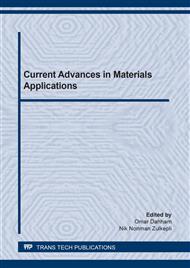p.319
p.331
p.340
p.350
p.360
p.369
p.379
p.389
p.399
Synthesis and Characterization of some 2-Azetidinones Derived from 3-Nitro Phthalic Anhydride and Evaluation their Biological against Bacteria and Fungi
Abstract:
Reaction of the moiety 3-nitro phthalic anhydride with p- Phenylene diamine in (40 ml) acetic acid to give compound (p-amino phenyl)-3-nitro phthalimide (A1).Which that react with different aromatic aldehyde in ethanol absolute to give compounds hydrazone (A2-A5), then react this compounds (A2-A5) with chloro acetyl chloride in presence of TEA by using DMF as solvent to obtain 2-azetidinones (A6-A9).The compounds of all the newly synthesized structures were confirmed by and ,IR, 1H NMR as well as melting point. Some of these new structures showed antimicrobial activity (A7-A8) and anti-bacterial activity (A7-A8).Antibacterial activity of some prepared compounds against two types of bacteria: Staphylococcus aureus (Gram positive) and E.coli (Gram negative). Some the compounds showed high inhibition activity against bacteria and two fungi (Candida albicans) and (Candida tropicalis.).
Info:
Periodical:
Pages:
360-368
Citation:
Online since:
July 2020
Price:
Сopyright:
© 2020 Trans Tech Publications Ltd. All Rights Reserved
Share:
Citation:


